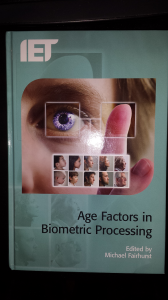Book Review: Age Factors in Biometric Processing

If you work in the biometrics industry or you happen to follow it closely, you are probably aware that a topic of discussion that frequently comes up is how does the aging of the human body effect the way that biometric systems are designed and deployed. In fact, a recent industry dust up saw researchers at The University of Notre Dame dispute the conclusions of a National Institute of Standards & Technology (MIST) study that the aging of the iris in humans does not have a significant impact in their ability to be identified in an iris biometric authentication system. The NIST study actually came on the heels of The University of Notre Dame’s study that age does in fact play a role in an iris biometrics identification system inability to recognize an individual previously enrolled in the database. Potato vs. Potatoe? Right now, it’s difficult to tell which report to believe.
What’s clear is that as the field of biometrics for identification management continues to expand and evolve, increased stringency will be placed on the affect that aging has on biometric systems and biometric research and development companies will be close attention to research and experimental results on this topic. The industry will be pleased to know that a new book by Michael Fairhurst has just been published called: “Age Factors in Biometric Processing” by The Institution of Engineering and Technology (IET) which details the effect that human aging has on the long term performance of biometric systems. Perhaps foreshadowing for just how complicated and in-depth this issue is, Fairhurst writes in his Introduction:
“It is clear, therefore, that the question of what the effects of human aging are likely to be in relation to biometric measurements, and how this phenomenon affects the performance of a particular biometric system, is very complex, and will almost certainly depend on many very different factors.”
Mr. Fairhurst assembles his book into four primary sections:
1.) An introduction to the aging process and an overview of biometric systems – setting the stage for discussion on how aging can effect individual biometric modalities
2.) A study of how aging effects specific biometric modalities including physiological and behavioral modalities
3.) A closer look at the topic of aging from the perspective of an industrial viewpoint, a forensics perspective, and the impact of aging on one of the more popular biometric modalities – facial recognition
4.) A look to the future and based on the conclusions of this book, what type and the scope of research that may be needed in the future
The book is highly technical in nature, offering an array of charts, graphs, photos, and mathematical equations throughout that help explain and support the conclusions the researchers put forth. Most chapters include a brief conclusion at the end that summarize the results of each experiment and research. A quick read through the book and an interpretation of the researchers’ conclusions clearly tells us that they overwhelmingly felt that age does indeed have a detrimental effect on biometric processing since “aging introduces variability of key biometric features over time.” Another important point that the researcher’s postulate is that the comparison of the aging of one person is not enough to predict how a much larger biometric system will act and it’s important to include as large a pool of individuals as possible to assess recognition performance results.
We were happy to see this important research text published and made available to help further explain the effect that aging has on the construction and performance of biometric identification systems. Age Factors in Biometric Processing is available through IET’s Web site by clicking here.
What are your conclusions on how aging effects biometric identification?











Pingback: Book Review: Age Factors in Biometric Processing – M2SYS Blog On Biometric Technology | Kenneth Carnesi